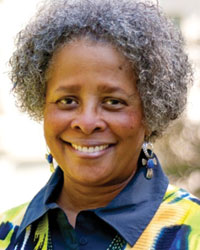Presidential Column
Diversity Makes Better Science
I’m honored to co-author this column with my colleague and friend Carol Lee. Among Carol’s many honors is having been President of the American Educational Research
Association (AERA). – DLM

Douglas L. Medin
It’s not news that minorities are severely underrepresented in both science and science education. Efforts to increase diversity typically fall into two broad classes: some motivated by a concern for equity and social justice, and others motivated by a concern for increasing the pool of scientists that are prepared to address contemporary needs in science and technology. Our purpose in this column is to draw attention to another compelling rationale for increasing diversity in the sciences, a rationale that is intrinsic to the process of scientific inquiry and to the effectiveness of science education. We start from an expansive conception of science that includes not only the biological, physical, social, and psychological sciences, but also the practices within these disciplines, the ecological validity of their research programs, and the manner in which novices — especially K-12 students — learn these disciplines.

Carol D. Lee
Our point is that attention to cultural membership and cultural practices is central to equity goals and national needs, but also equally important for the construction of knowledge and for the enterprise of science itself. Moreover, we cannot and do not shed our cultural practices at the door when we enter the domain of science, science education, or science learning.
Before defending this claim, we need to clarify that we do not subscribe to a “box model” of diversity in which gender or ethnicity are essentialized or reduced to a list of internal traits. Instead, we focus on the diversity of life practices, perspectives, values, and motivations that are often correlated with these groupings (Gutierrez & Rogoff, 2003).
Validity in the sciences involves much more than attending to canons about the need for proper controls, replicability, and the like. It involves choices about what problems to study, what populations to study, and what procedures and measures should be used. In making these choices, diverse perspectives and values are important. Consider the strong correlation between social-science researchers and the people they study. This predominantly White middle-class group of scientists focuses their research programs primarily on White, middle-class populations. This reliance on “convenience samples” (using undergraduates from introductory psychology courses is the paradigmatic example) does not stem from purposeful neglect of other potential samples. Nonetheless, it has disadvantageous consequences, including the fact that results based on this narrow slice of humankind may not, and often do not, generalize to other populations (Henrich, Heine, & Norenzayan, 2010).
Diverse perspectives and values also affect a researcher’s choice of methods. Consider, for example, wildlife biologist Flo Gardipee, who studies population structure and gene flow in North American bison. Her First Nations perspective (she is Cherokee and Irish) led her to seek non-invasive methods for sampling buffalo DNA. She has pioneered the practice of using fecal samples for DNA collection (Gardipee et al., 2007). This method allows the widespread sampling of free-ranging bison populations with minimal human interference to their behavior and activities.
Diverse perspectives often are associated with diverse research foci and the generation of new findings. For example, when female scientists began to study primate social behavior, new insights into both female and male behaviors were uncovered (Hrdy, 1986).
In various fields of psychological science, minority scholars and culturally oriented majority scholars have expanded previously accepted conceptions of identity development, motivation, and resilience (Graham & Hudley, 2005; Spencer, 2006). For example, broadly accepted theories arguing for the primacy of an internal locus of control have been contested, pointing to the efficacy of an external locus of control when populations face persistent stigmatization that they do not control (Crocker & Major, 1989). Research on the role and complexity of racial socialization has pushed boundaries around accepted conceptions of identity development (Bowman & Howard, 1985; Boykin & Toms, 1985).
On a more abstract level, there are formal proofs that diversity of orientations can even trump ability in problem solving. For example, Scott Page (2007) has documented how the presence of diverse perspectives (including gender and ethnic diversity) in collective problem-solving in business and other organizations leads to more innovative solutions. Even when the focus is on the same topics with the same methods and measures, diversity may help. The sociology of science tends to converge on accuracy when different biases or errors cancel each other out, but this is less likely to happen when lack of diversity leads to correlated error.
Another warrant for consideration is evidence of the fundamental role of culture in human learning, suggesting that there is no reason to think learning in science or the practices of science is somehow acultural or simplistically universal. Current developmental research in both cultural psychology, as well as cultural and social neuroscience, underscores the fact that human development is an outgrowth of dynamic relations between our biological endowments and the shaping role of our environment. Indeed, developments in the fields of cultural and social neuroscience provide a window into how human learning is an outgrowth of the threading of biological and environmental (i.e., cultural) resources, from the levels of epigenetic change to broader life-course trajectories (Quartz & Sejnowski, 2002).
If participation in cultural practices is central to our development as humans, then how we learn science, for example, will be influenced by the range of practices in which we routinely engage (Bang, Medin, & Altran, 2007; Herrmann, Waxman, & Medin, 2010; Lee, 2008). These diverse pathways for learning and development enhance our ability as a species to survive. What such diversity means for the teaching and learning of science, particularly in K-12 environments, remains a significant challenge that we think has important implications for achieving greater equity in opportunities to learn science. This includes not only how students learn science, but what science they learn, and what conceptions of doing science become part of their repertoires.
Developing a robust epistemology of science is enhanced when students learn that knowledge in science is contested. Because the sciences are intended to have predictive or explanatory power, challenges to ecological validity often arise from diverse of points of view. These contestations have been documented nicely in the history of science, especially when scientific practices and investigations went beyond a Eurocentric focus. Osborne and others have argued for the importance of teaching the history of science in K-12 education (Monk & Osborne, 1997). For example, attention to indigenous knowledge systems for environmental sustainability illustrates scientific practices (which include replicability and predictive value) that broaden traditional epistemologies (Atran & Medin, 2008). The fields of ethnobiology and ethnomathematics provide additional illustrations.
Our overarching argument is that both equity outcomes as well as knowledge production in the sciences are enhanced by attention to cultural diversity specifically diversity of ideas, methods, populations, and sites of scientific practice. Practices across the sciences, including psychological science, are cultural, and the norms that influence such practices emerge from across diverse sites, from diverse practitioners, addressing diverse problems. Just as the diversity of pathways for development within and across human populations does not argue there is nothing holding us as a species together, recognizing the cultural embeddedness of scientific research does not undermine the canons that hold the sciences together. Rather, it is the dynamic relations across sites of diversity that make for adaptability to changing circumstances, a hallmark for all kinds of development and growth.
Recognizing the cultural nature of science practices provides a new perspective on the engagement with and learning of science. When women and underrepresented minorities see their own orientations and practices recognized and supported as relevant to the practices of science, the field of science should seem much more attractive to them. But our key thesis is that our sciences will be all the better for the perspectives that diverse scholars can bring to them. A psychological science owned and operated by Western, White middle-class scholars resembles a self-ethnography more than a true psychological science.
Footnotes
[] Locus of control refers to a theory developed by Julian B. Rotter. Individuals with an internal locus of control believe that they are in control of their lives. In contrast, individuals with an external locus of control believes that their environment, a higher power, or other people control their life.





Comments
Excellent column. Succinctly and clearly stating what we always worked to accomplish in our work and publications while with APA and since then. The discussion in our new chapter (see the chapter by Kohout, Pate and Maton in forthcoming 2012 APA Handbook of Multicultural Psychology)echoes this piece.
APS regularly opens certain online articles for discussion on our website. Effective February 2021, you must be a logged-in APS member to post comments. By posting a comment, you agree to our Community Guidelines and the display of your profile information, including your name and affiliation. Any opinions, findings, conclusions, or recommendations present in article comments are those of the writers and do not necessarily reflect the views of APS or the article’s author. For more information, please see our Community Guidelines.
Please login with your APS account to comment.